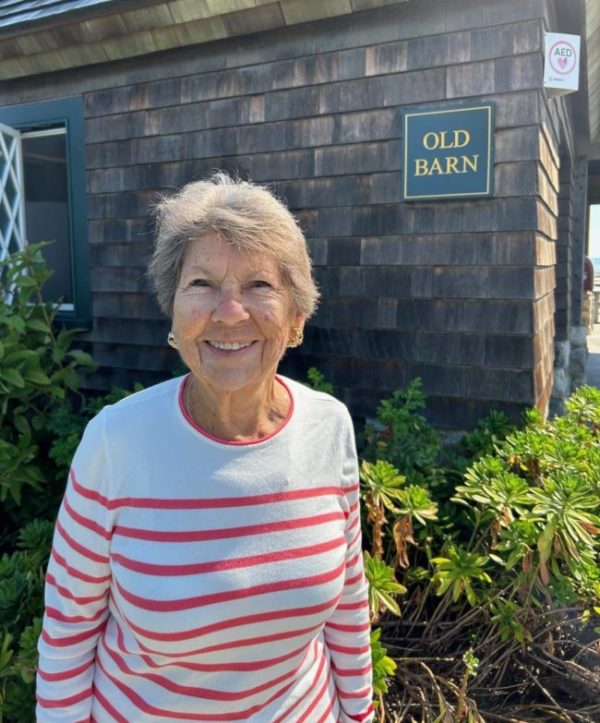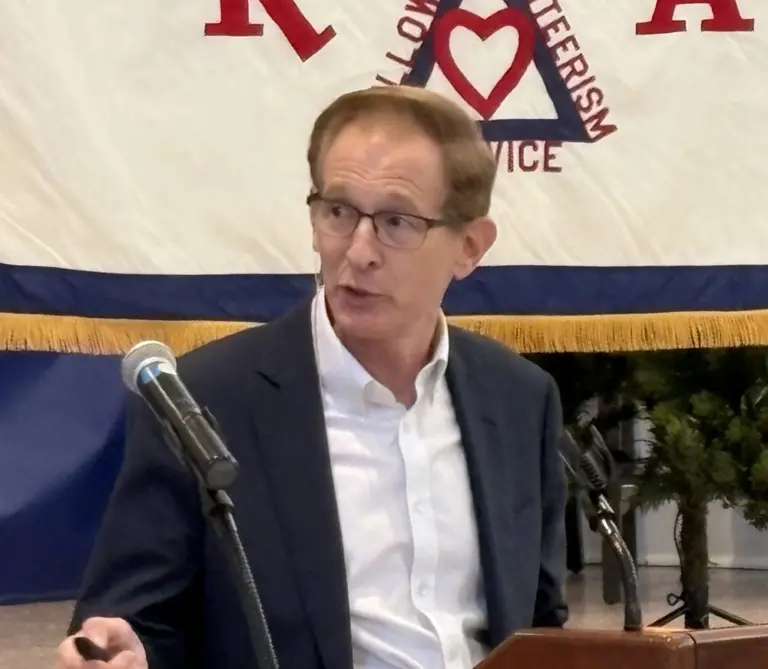
By Anne W. Semmes
For over half a century the life and contributions of Susie Baker have been woven through the history of the Town of Greenwich. She has been honored by multiple organizations but next Wednesday evening she will receive from the Greenwich Historical Society at its annual meeting, its highest individual honor, the David Ogilvy Award for her “lifetime work” in “the advancement of preservation in Greenwich and beyond.”
Just how that is spelled out in “worker bee” Susie Baker’s life, this reporter learned of while talking with her in an upstairs room of the Innis Arden Cottage overlooked by an impressive portrait of J. Kennedy Tod, once owner of Greenwich Point, with a window view of Long Island Sound. And she was most proud, she shared, of her part in saving the historic buildings of Greenwich Point.
“The town didn’t intend to save the historic buildings here,” she said. “What’s historic is this was the property of Elizabeth Feake,” and “that’s 1640. And she bought this property from the Native Americans for 11 coats – a bolt of wool. So that’s the history of Greenwich. That’s where it begins. And then to think that it was finally owned by Mr. Tod.”
The Innis Arden Cottage had played a part in Baker’s 25 years of teaching at Greenwich High School in marine biology and oceanography wherein she and teacher colleague Dan Barrett had used part of the Cottage as a marine science lab for their students. “You can study everything here. We have rocky habitats, a sandy beach habitat, a marsh habitat, a mud flat habitat.”
But with the deteriorating Cottage and nearby barn, and no town plan to save the buildings – “It was just on the books for a bulldozer…” To save the buildings Baker joined with three other women to form the Greenwich Point Conservancy (named first as Friends of Greenwich Point). With the need to learn more of the buildings’ history Baker reached out to the Greenwich Historical Society and then president, Claire Vanderbilt.
Baker had been a part of the Historical Society from first moving to Greenwich with her family 56 years ago. “I just joined to become a member in the community,” she said. A highlight in those membership years was serving in 1976 as a docent in the 200th year celebration of the town of Greenwich. “We put together this amazing program for all the third graders in town to have a field trip. But it was not the Cos Cob Art Colony then, it was the old Sarah Bush House, and I just loved every bit of that old history of when the grist mill was out in front – I just learned so much about the town’s history acting as a docent.”
Returning to her work with the Greenwich Point Conservancy, she noted its aims were for “conservation and preservation. And the Historical Society is more about preservation of the past.” Conservation for Baker “is more focused on natural resources and saving what we have.” Pointing to the now restored Cottage and next-door Old Barn, she said, “This is building conservation,” adding, “This is history preservation.”
For Baker’s years of working for that preservation and conservation through the Conservancy, the Old Barn and adjoining building were named the Susie Baker Pavilion in 2014.
But Baker continued, “The Historical Society is not in the business of buying historical properties. They’re in the business of preserving the history, archiving the history, and educating people… And they built in recent years the Vanderbilt Barn, where they can do their educational programs, and they can sponsor all kinds of events. And they have the new space for the archives, and they also have a wonderful summer camp for children that’s teaching history, and some outdoor activities teaching natural history to all the kids in our town. So, they play a great role.”
Questioned about the late David Ogilvy for whom her Historical Society Award is named she cited Ogilvy as “a major contributor to the Society in every way. He also was an early board member of the Greenwich Land Trust and one of its presidents. The Greenwich Land Trust is preserving properties and open space, just as the Greenwich Historical Society is preserving the history – and they’re both conservation ideas. They’re both saving, conserving, and protecting. And so that’s where a lot of David’s energy and time and treasure went in our town.”
For Baker, protecting the open space in Greenwich is “the most important thing we have to worry about,” she said. “And it’s kind of hard to do. We have good zoning regulations for the backcountry areas of four acres. The Conservation Commission and the Planning & Zoning Commission in the town of Greenwich work hard to assure conservation set asides and conservation easements on all properties that are developed. And when you do that, you start protecting the natural world. You protect the waterways; you protect overdevelopment in terms of the population.”
She’s also “passionate about Long Island Sound and its being clean,” she said, “And I’m passionate about keeping the waterways clean, and the open space preserved. And to do all that you have to honor the history after knowing what was there.”
There’s a quotation that says it all for Baker, by a Senegalese engineer and forest scientist, Baba Dioum: “In the end, we will conserve only what we love; we will love only what we understand, and we will understand only what we are taught.” She found it on “a little plaque” she saw at the Bronx Zoo. She wrote it down. “That was long before there were cell phones to take a picture.”
She insisted her students memorize it, “and they kept saying, ‘Why? Why? Why?’ And periodically we’d talk about it, and I would say, ‘That’s why I’m here.’ And then on their final exam, I always said, now they had to write the poem – and it’s true. And one of my students wrote it calligraphy-like, decorated it with sparkles, and put it in a frame and gave it to me – it’s on my breakfast table.”






